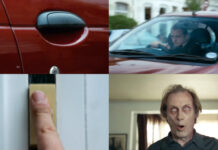Eye contact is one of the most foundational components of effective communication. Psychologists know this. Professional presenters know this. Teachers know this. Parents know this. But based on the number and regularity of “ear shots” that make their way into professionally produced videos, producers and editors still don’t seem to grasp that this key component of connected communication applies as much to video production as it does in person.
Broadly speaking, the television screen is either used as a one-way window pane or as a two-way communication portal.
To be fair, there are different types of video production, and each type comes with its own unwritten rules in regard to whether or not the people on screen look into the lens or not. Broadly speaking, the television screen is either used as a one-way window pane or as a two-way communication portal. Producers need to shoot and edit based on the predetermined use of the screen.
The one-way window
In story-based entertainment productions, the screen typically acts as a magical one-way picture frame. Through it, the viewer voyeuristically peers into the world of the characters as their story unfolds. This magical frame has powers of location, position and perspective that override the limitations of time and space. The point of view can quickly change within a single setting to offer an unlimited number of viewpoints, or it can transport the viewer thousands of miles, or span many years, in the blink of an eye. In this context, the viewer may experience the emotions of the characters, but always and only as an outside observer, not as an active participant in the production. The actors never look directly into the lens. In fact, if a person in this type of program looks into the lens, the scene is ruined and the director calls for another take.
The two-way portal
In other productions, the subject featured on screen looks through the lens as though he is speaking directly to each individual viewer. This simulates the kind of personal connection that one would experience in a face-to-face conversation. This approach is typically used to communicate information or instruction. It can be seen everyday in news, talk shows, instructional programs and training videos. The person on-camera talks directly to the viewer as if he were a personal friend peering through the lens into the living room.
A scene may be introduced with a montage of shots from varied perspectives, or a slight push in on the host as the music plays. These function as establishing shots to set the scene. You might see reverse angle behind-the-scenes shots used in a promo for a program. However, as soon as the host greets the viewer and begins speaking, the camera locks into place. It becomes the eye of the viewer as though we were pulling up a chair a couple feet away from the news desk. The viewer enters into the time and space restraints of the setting through the lens. There are very few camera moves or changes in lens setting in this type of program. The camera operator becomes the viewer’s body. When the camera operator pans or tilts the video camera, it is as though the viewer turned his head. When the camera person walks along with the host, it is as though the viewer were walking, too. The viewer virtually enters into the production vicariously through the camera person. When Ty Pennington says, “Come with me,” or when Brian Williams says, “See you next time,” we know they can’t see us. We know we aren’t there with them. But this type of production creates the illusion of a personal, intimate, connection and it feels natural.
Pick your perspective
As producers, we need to understand that viewers subconsciously know the difference between these two approaches to production. While both are valid, in order for either to hold up from a psychological point of view, they cannot be combined. It would feel incredibly awkward if you and I were having an in-depth conversation over lunch and you suddenly changed chairs and looked at my ear for a few seconds while I continued to talk to the empty chair that you had just evacuated. The problem is not necessarily in the change of perspective. Changing shots can absolutely provide variety and interest. But, if you move, I would need to turn my head to maintain eye contact. If I didn’t redirect my gaze to look you in the eye it would just be — weird. Socially awkward. Inappropriate. Likewise, it would be odd if you remained in the same seat but I suddenly turned my head 90-degrees mid-sentence and, without missing a beat, began talking to the wall while you looked intently at my ear. This random change of perspective would break our eye contact, and disengage our personal connection.
Shots that change perspective are a highly desirable device for drawing viewers deeper into one-way window productions, but the very same device is counterproductive in the context of two-way portal programs. Make sure you enter into every production with a clear idea of your viewers’ role, then shoot and edit in a way that best communicates the content of your message to that viewer.
Chuck Peters is a 3-time Emmy award-winning writer and producer. He is currently Director of Operation for LifeWay Kids in Nashville, TN.







